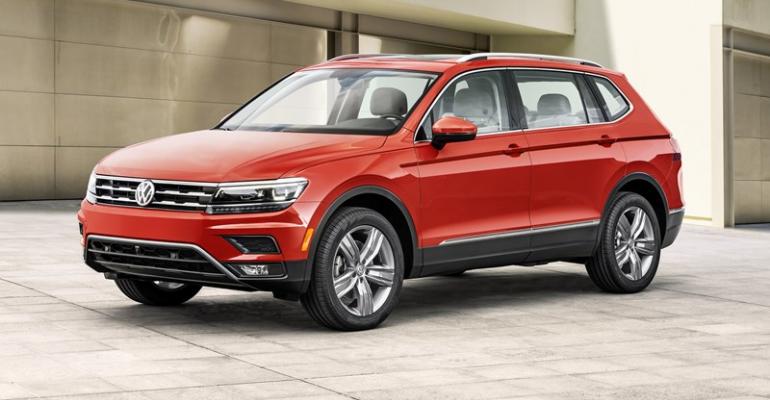CHICAGO – Credit Volkswagen’s MQB architecture for the spaciousness of the upcoming ’18 Tiguan CUV. But thank the German automaker’s designers for giving the vehicle its expansive appearance.
At a styling review for the second-generation CUV here, VW exterior designer Johannes Brandsch applauds the proportions of the longer Tiguan coming to the North American and European markets later this year. The larger model, to be built at VW’s plant in Puebla, Mexico, also will be built and sold in China.
The larger Tiguan rides on a 109.9-in. (2,791-mm) wheelbase that is 4.4 ins. (112 mm) longer than its counterpart already on sale in Europe. Overall, the vehicle measures 185.2 ins. (4,704 mm), 10.7 ins. (272 mm) longer from the B-pillar rearward compared with the current model and 8.6 ins. (218 mm) longer than the European version.
The extra space gives the all-new model 57% more cargo room, a sliding second row and the opportunity for a 2-seat third row (standard on front-drivers, optional on all-wheel-drive models).
Brandsch says the larger template called for distinct and connected character lines wrapping around the body to create an expansive appearance, with extreme negative side cuts and a tighter greenhouse imparting a masculine feel. Up front, large wraparound headlights fitted with slim LED indicator lights give the Tiguan a strong SUV look.
“Overall, we tried to be very precise with the lines,” Brandsch says. “For us, this logic is important. All the lines need to connect.”
The benefits of the MQB platform are even more evident inside where interior designers Ina Janisch and Leo Natterer paid special attention to creating a wide, horizontal layout to enhance the spaciousness.

The designers’ demand for precise and clearly defined lines wrapping from the dashboard into the doors “was specifically an area where we lost many friends,” jokes Natterer. Janisch recalls similar demands for a chrome trim element defining the center stack that required a precise fit.
“The design is very precise and that shows quality,” she explains.
Added space and the better design of the MQB platform aided rear-seat work, the designers note. For instance, with more room behind the B-pillar, foot clearance is better, allowing for easier second-row entry and exit.
That said, the third row in the Tiguan isn’t easily accessible – even with sliding second-row seats – and is hardly usable by anyone but small children. VW’s larger 3-row, 7-seat Tennessee-built Atlas CUV arriving midyear ahead of the Tiguan is the better choice for buyers who regularly need the extra row of seats.
VW has high hopes for its new products, calling 2017 “the year of the #SUVW.” Tiguan’s 43,636 sales in 2016 totaled half the volume of its competitors. Overall, VW sold 322,948 vehicles in 2016, down 7.6% from 2015.
[email protected] @bobgritzinger





